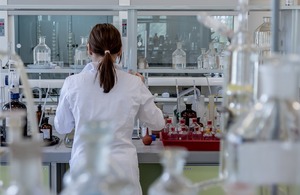Interim results from largest COVID-19 study published
Over 80,000 volunteers tested in England between 18 and 26 September as part of the country’s largest study into COVID-19.

- Interim findings from Imperial College London and Ipsos MORI show 1 in 200 people were infected but suggest growth of infection may be slowing
- Figures reinforce the need for everyone to play their part remembering hands, face and space, the rule of 6 and self-isolation for those who risk passing on the virus
Interim results from the fourth report of the country’s largest study on coronavirus rates of infection have been published today.
The study examines levels of infection in the general population in England by testing over 150,000 participants each month over a 2-week period.
Over 80,000 volunteers out of 150,000 have been tested so far between 18 and 26 September. Findings show infections increased substantially across the country before the R rate fell to around 1.1, suggesting the growth of infection may be slowing. It is estimated 1 in 200 people in England were infected with the virus, reinforcing the need to remain vigilant.
Today’s report shows prevalence of infection increased across all age groups and regions. Infection was highest in those aged 18 to 24 with 1 in 100 people infected, and cases increased seven-fold in those aged over 65. The North West had the highest levels of infection and the number of infections in London increased five-fold.
The final report and findings of all 150,000 volunteers tested between 18 September and 5 October will be published next week.
The high rate of infection reinforces the need for the public to follow the latest rules. Individuals must only meet socially in groups of up to 6 people in any settings indoors or outdoors, including your home, restaurants and pubs. There are some exemptions including organised sports, weddings and funerals and formal childcare.
It is important to continue to keep your distance from others outside your household, download the NHS Test and Trace app and follow advice from NHS Test and Trace if contacted. If you develop symptoms you must self-isolate, along with your household, and get a test. Some areas in England are subject to other local restrictions and it is vital residents follow the rules in place in their area.
Professor Paul Elliott, Director of the programme at Imperial from the School of Public Health, said:
While our latest findings show some early evidence that the growth of new cases may have slowed, suggesting efforts to control the infection are working, the prevalence of infection is the highest that we have recorded to date.
This reinforces the need for protective measures to limit the spread of the disease and the public’s adherence to these, which will be vital to minimise further significant illness and loss of life from COVID-19.
Kelly Beaver, Managing Director- Public Affairs at Ipsos MORI, said:
The continuing support of the public by taking part in the study is something we remain immensely grateful for.
The number of participants gives this study the robustness and thoroughness which marks it out as world leading. Ipsos MORI would like to thank everyone who’s volunteered so far and those who will volunteer for further rounds of this study.
The report was commissioned by the Department of Health and Social Care (DHSC) and carried out by a world-class team of scientists, clinicians and researchers at Imperial College London, Imperial College Healthcare NHS Trust and Ipsos MORI.
Background information
Top findings for over 80,000 volunteers between 19 and 26 September (9-day period) compared to previous study (24 August to 7 September).
- 363 out of 84,610 volunteers tested positive with prevalence of 0.55%. It means 55 people per 10,000 are infected, which is an increase on 13 people per 10,000 in the last report.
- This implies 411,000 people in England have the virus that causes COVID-19 meaning over 1 in 200 people were infected at any one time.
- Prevalence has increased across all ages. Prevalence was highest in those aged 18-24 at 0.96% meaning 1 in 100 people in this age group are infected. In the 65+ age group prevalence increased 7-fold from 0.04% to 0.29% compared to the last report.
- Prevalence increased in all regions. Highest prevalence is the North West at 0.86%. London has increased 5 fold from 0.10% to 0.49%.
- R rate has decreased from 1.7 to 1.1 suggesting some deceleration, but with considerable uncertainty.
- People of Asian and black ethnicity are twice as likely to have the virus that causes COVID-19 compared to white people
- 50% of test positive volunteers did not have symptoms at the time of testing or the week before, but this does not mean they did not later develop symptoms.
The pre-print report can be accessed.
The report was commissioned by DHSC and carried out by a world-class team of scientists, clinicians and researchers at Imperial College London, Imperial College Healthcare NHS Trust and Ipsos MORI.
More information on the REal-time Assessment of Community Transmission (REACT) programme.
This study falls under pillar 4 of the COVID-19 National Testing Programme, which focuses on mass surveillance in the general population. This is the second study which looks at a representative cross-section of the whole population.